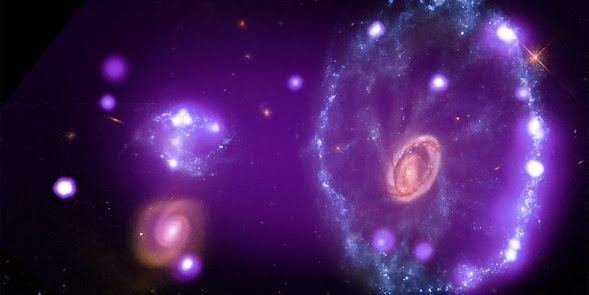NASA's Chandra X-ray Observatory is a super powerful telescope named after the Nobel Prize-winning astrophysicist Subrahmanyan Chandrasekhar. It has a history of delivering some incredible astronomical discoveries. It provided the first light image of supernova remnant Cassiopeia A. In the year 2000, high school students used data from the telescope to discover a neutron star in supernova remnant IC 443.
Image Credits: NASA/CXC/SAO, NASA/STScI, NASA/JPL-Caltech/SSC, ESO/NAOJ/NRAO, NRAO/AUI/NSF, NASA/CXC/SAO/PSU, and NASA/ESA
Now it's helped produce some dazzling images of galaxies, stars, planetary nebulae and supernova remnants.
At the risk of stating the obvious: Space is pretty wild.
To be clear, these images aren't necessarily representative of what can be seen with the human eye. They've been put together using data, not just from Chandra, but from multiple other sources. They take what NASA calls a "multiwavelength' approach, using data across multiple different spectra, from radio waves to gamma rays.
Let's go through them all.
M82
X-ray: NASA/CXC; Optical: NASA/STScI
Not to be confused with the sick French band M83, NASA says M82 is a galaxy that is "oriented edge-on to Earth".
Abell 2744
NASA/CXC; Optical: NASA/STScI
A galaxy cluster image using data from the Chandra and Hubble telescopes.
Supernova 1987A (SN 1987A)
Radio: ALMA (ESO/NAOJ/NRAO), P. Cigan and R. Indebetouw; NRAO/AUI/NSF, B. Saxton; X-ray: NASA/CXC/SAO/PSU/K. Frank et al.; Optical: NASA/STScI
Probably the wildest image of the lot. According to NASA this is an image of one of the "brightest supernova explosions in centuries".
Eta Carinae
NASA/CXC; Ultraviolet/Optical: NASA/STScI; Combined Image: NASA/ESA/N. Smith (University of Arizona), J. Morese (BoldlyGo Instituts) and A. Pagan
NASA describes Eta Carinae as "a volatile system containing two massive stars that closely orbit each other".
Cartwheel Galaxy
X-ray: NASA/CXC; Optical: NASA/STScI
When Fritz Zwicky discovered this galaxy in 1941, he said it was "one of the most complicated structures awaiting its explanation on the basis of stellar dynamics." It's 150,000 light years in diameter.
Helix Nebula
X-ray: NASA/CXC; Ultraviolet: NASA/JPL-Caltech/SSC; Optical: NASA/STScI(M. Meixner)/ESA/NRAO(T.A. Rector); Infrared: NASA/JPL-Caltech/K. Su
It looks like a giant eyeball, but the Helix Nebula is actually a star running out of fuel. Apparently this is what could happen to our sun in 5 billion years.








